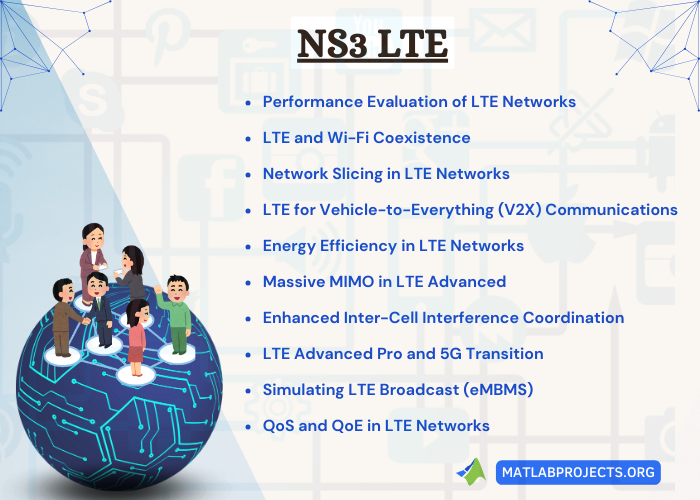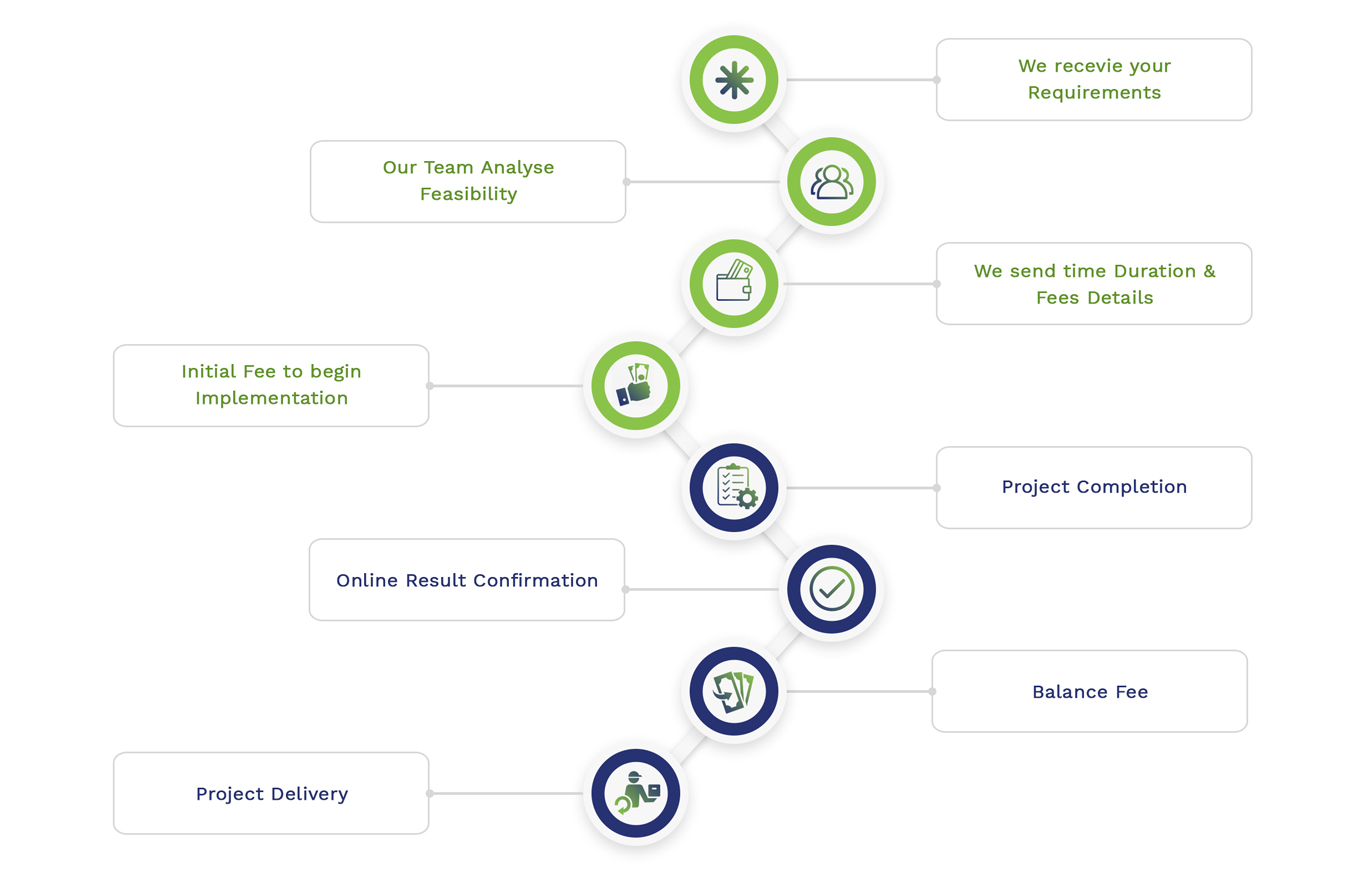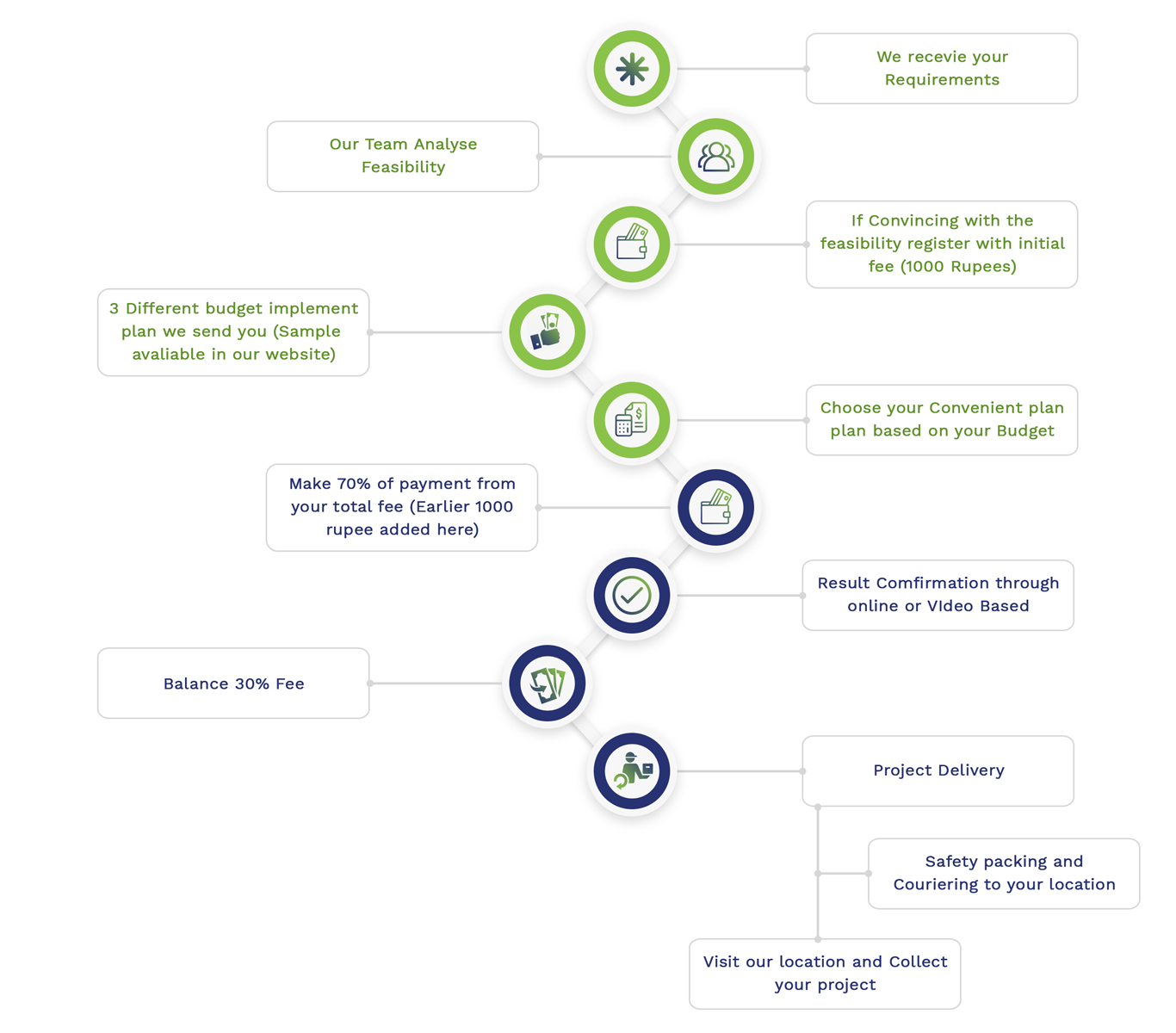The simulator NS-3 is used for developing, testing and improving LTE networks and services. We provide a list of various project plans and topics that are applicable for thesis work, educational research and individual’s passion. These topics can be followed by utilizing NS-3 for powerful LTE simulations:
- LTE and Wi-Fi Coexistence
- Explanation: By aiming at systems for perfect spectrum distribution and intervention handling particularly in the framework of LAA (Licensed Assisted Access) and LTE-U (LTE-Unlicensed), research the coincidence of LTE and Wi-Fi networks.
- Goal: For improving the efficiency of Wi-Fi as well as LTE networks and optimizing the utility of unlicensed spectrum, discover novel plans.
- Performance Evaluation of LTE Networks
- Explanation: Based on latency, packet loss and throughput on various situations like diverse stages of network load, many allocation methods or different levels of user mobility, research the efficacy of LTE networks.
- Goal: In LTE networks, detect possible enhancements by analyzing how the quality of service is impacted by various factors.
- LTE Advanced Pro and 5G Transition
- Explanation: To determine the incremental improvements and in what way they set the stage for future network abilities, design the growth from LTE Advanced to LTE Advanced Pro and ultimately to 5G.
- Goal: In the transformation process, interpret the technical developments that are directed to 5G and the duty of LTE.
- Energy Efficiency in LTE Networks
- Explanation: For enhancing the energy effectiveness of LTE networks, aim at the influence of network model options on the entire power consumption and also create plans along with methods for energy storing in base stations.
- Goal: To mitigate the energy footprint of LTE networks without convincing the efficacy, detect some directions.
- Network Slicing in LTE Networks
- Explanation: According to the particular needs, analyze in what way the materials can be assigned to various slices and then utilize NS-3 to design and simulate network slicing into the LTE networks.
- Goal: In assisting different application needs inside an individual real network structure, assess the efficiency of network slicing.
- LTE for Vehicle-to-Everything (V2X) Communications
- Explanation: Evaluating the strength to serve the high authenticity and low latency that are necessary for several automatic applications by simulating the usage of LTE for v2X interactions.
- Goal: For permitting secure and highly effective transportation mechanisms, examine the attainability and problems of employing LTE.
- QoS and QoE in LTE Networks
- Explanation: To interpret their effect on user experience, simulating various Quality of Service (QoS) strategies and traffic kinds such as video streaming and VoIP and then observing Quality of Experience (QoE) and QoS in LTE networks.
- Goal: For several applications in LTE networks, construct policies to improve QoE and QoS.
- Massive MIMO in LTE Advanced
- Explanation: By concentrating on features like dimensional multiplexing, channel estimation and beamforming, research the application and strength of massive Multiple Input Multiple Output (MIMO) techniques in LTE Advanced networks.
- Goal: For improving the coverage and ability of the network specifically, discover the possibility of massive MIMO.
- Enhanced Inter-Cell Interference Coordination (eICIC)
- Explanation: In heterogeneous LTE networks in which small cells and macrocells live together, simulate the deployment and enhancement of eICIC systems.
- Goal: On dense and heterogeneous network deployments, explore how eICIC can increase the efficiency and reduce the intrusion.
- Simulating LTE Broadcast (eMBMS)
- Explanation: Targeting the situations like smart signage, telecasting during emergencies and live video streaming, discover the implementation of Evolved Multimedia Broadcast Multicast Services (eMBMS) in LTE for robust concept sharing.
- Goal: For multicast and broadcasting services, validate the advantages and problems of utilizing LTE.
How to simulate LTE networks using NS3?
Simulating LTE networks through the NS3 simulator for academic or research areas is a challenging but rewarding process. Generally, NS3 is a discrete-event network simulator for internet frameworks. We offer you a simple direction to effectively simulate LTE networks with the assistance of this simulator:
- Install NS-3
Confirm that you have installed the NS-3 simulator on your system initially. You can download the advanced version of NS-3 which contains overall features that are required, as the LTE module is integral with the traditional NS-3 dispersion. Either duplicate the database from NS-3 authorized Git database or download NS-3 from its legal website.
- Understand the LTE Model in NS-3
The EPC and E-UTRAN are the two major phases of the LTE framework in NS-3. The EPC handles the entire network structure such as the Packet Data Network Gateway (P-GW), serving Gateway (S-GW) and Mobility Management Entity (MME), likewise the E-UTRAN manages the radio features like the user equipment (UE) and the base stations (eNBs).
- Create a Simple LTE Simulation Script
Through C++ we give you the simple example of how to establish a basic LTE network simulation in NS-3. Including an internet link from the EPC, the following script develops an individual eNBand multiple UEs that are linked to it:
#include “ns3/core-module.h”
#include “ns3/network-module.h”
#include “ns3/internet-module.h”
#include “ns3/mobility-module.h”
#include “ns3/lte-module.h”
#include “ns3/config-store-module.h”
using namespace ns3;
NS_LOG_COMPONENT_DEFINE (“LteSimpleSimulation”);
int main (int argc, char *argv[])
{
CommandLine cmd;
cmd.Parse (argc, argv);
// Log component enable can be used to show detailed logs
// LogComponentEnable (“LteSimpleSimulation”, LOG_LEVEL_INFO);
// Create nodes: one eNB and multiple UEs
NodeContainer enbNodes;
enbNodes.Create(1);
NodeContainer ueNodes;
ueNodes.Create(2); // Change the number of UEs here
// Install LTE Devices to the nodes
NetDeviceContainer enbLteDevs = LteHelper->InstallEnbDevice (enbNodes);
NetDeviceContainer ueLteDevs = LteHelper->InstallUeDevice (ueNodes);
// Install the IP stack on the UEs
InternetStackHelper internet;
internet.Install (ueNodes);
Ipv4InterfaceContainer ueIpIface =epcHelper->AssignUeIpv4Address (NetDeviceContainer (ueLteDevs));
// Attach UEs to the eNB
for (uint32_t u = 0; u < ueNodes.GetN (); ++u)
{
lteHelper->Attach (ueLteDevs.Get(u), enbLteDevs.Get(0));
}
// Set the EPC Address and configure the internet
Ptr<Node> pgw = epcHelper->GetPgwNode ();
// Setup routing and remote host if needed
Simulator::Stop (Seconds (10)); // Set the stop time of the simulation
Simulator::Run ();
Simulator::Destroy ();
return 0;
}
You can get started through this easy example. You are able to modify different features of certain QoS platforms, mobility frameworks for the UEs and like various kinds of use-cases to produce traffic like video streaming and VoIP actually.
- Running the Simulation
Compile your script in the context of your NS-3 project to execute your simulation. Depending on your creation platform and installation the unique compilation procedures can differ. To compile and execute your project, you could include your script to the scratch folder in the NS-3 directory and then implement the ./waf build model in a common way.
- Analyze the Results
For observing simulation outcomes along with visualizers and trace files, NS-3 offers different tools. To gather and examine network strength metrics, you can employ the in-built ns3::FlowMonitor module or configure the simulation to obtain pcap and log files.
- Expand Your Simulation
Establishing simulations which include transfers among eNBs, incorporating inter-cell interference coordination (ICIC) systems, simulating mobility designs and validating the impacts of different allocation methods are the highly modern situations and aspects that are being examined and investigated.

NS3 LTE Project Topics & Ideas
Explore the latest trends with our collection of NS3 LTE Project Topics & Ideas. With over 6000 completed projects, we have gained the trust of customers worldwide. Let us help you reach your goals with top-notch guidance. Our literature surveys are based on the most recent IEEE papers, ensuring transparency in our work. Trust us to lead you towards a successful project.
- Outline of 4G Unlicensed Bands in 3GPP LTE-Advanced Operator Duplex
- Design of a Dual-Polarized High-Gain Yagi Antenna Array for 2G/3G/LTE Base Stations
- A Compact Broadband Circularly Polarized Wide-Slot Antenna With Axial Ratio Bandwidth Encompassing LTE 42 and LTE 43 Standards of 5G Mid-Band
- Dynamic Spectrum Sharing for 5G NR and 4G LTE Coexistence – A Comprehensive Review
- Enabling Uncoordinated Dynamic Spectrum Sharing Between LTE and NR Networks
- Heartbeating with LTE Networks for Ambient Backscatter
- Downlink Decoding Based Accurate Measurement of LTE Spectrum Tenancy
- An Efficient and Fair Wireless Resource Allocation Scheme for LTE and Wi-Fi over Unlicensed Bands
- Research on Model and Simulation of Vehicle Network Based on LTE Technology
- LTE RSSI Based Vehicular Localization System in Long Tunnel Environment
- Experimental End-To-End Delay Analysis of LTE Cat-M With High-Rate Synchrophasor Communications
- DSRC Versus LTE-V2X: Empirical Performance Analysis of Direct Vehicular Communication Technologies
- In-Band Ambient FSK Backscatter Communications Leveraging LTE Cell-Specific Reference Signals
- Shared Aperture 4G LTE and 5G mm-Wave Antenna in Mobile Phones With Enhanced mm-Wave Radiation in the Display Direction
- Dual-Feed Shared-Radiator Metal-Frame Full-Screen Mobile Phone Antenna for GPS and LTE Bands With a Dual-Function Capacitor
- LTE transmitter states estimation using a combined code and carrier phase observation model
- Comparative study of QoS Measures in LTE Networks based on Software Defined Networking
- Joint Energy-Efficiency Communication Optimization and Perimeter Traffic Flow Control for Multi-Region LTE-V2V Networks
- Analysis of LTE Performance of V2V Communications on Indonesia Toll Road
- Performance Evaluation of Effective Cluster Head Selection and Maintenance for LTE Based Vehicular Ad-Hoc Networks
Subscribe Our Youtube Channel
You can Watch all Subjects Matlab & Simulink latest Innovative Project Results
Our services
We want to support Uncompromise Matlab service for all your Requirements Our Reseachers and Technical team keep update the technology for all subjects ,We assure We Meet out Your Needs.
Our Services
- Matlab Research Paper Help
- Matlab assignment help
- Matlab Project Help
- Matlab Homework Help
- Simulink assignment help
- Simulink Project Help
- Simulink Homework Help
- Matlab Research Paper Help
- NS3 Research Paper Help
- Omnet++ Research Paper Help
Our Benefits
- Customised Matlab Assignments
- Global Assignment Knowledge
- Best Assignment Writers
- Certified Matlab Trainers
- Experienced Matlab Developers
- Over 400k+ Satisfied Students
- Ontime support
- Best Price Guarantee
- Plagiarism Free Work
- Correct Citations
Expert Matlab services just 1-click

Delivery Materials
Unlimited support we offer you
For better understanding purpose we provide following Materials for all Kind of Research & Assignment & Homework service.
 Programs
Programs Designs
Designs Simulations
Simulations Results
Results Graphs
Graphs Result snapshot
Result snapshot Video Tutorial
Video Tutorial Instructions Profile
Instructions Profile  Sofware Install Guide
Sofware Install Guide Execution Guidance
Execution Guidance  Explanations
Explanations Implement Plan
Implement Plan
Matlab Projects
Matlab projects innovators has laid our steps in all dimension related to math works.Our concern support matlab projects for more than 10 years.Many Research scholars are benefited by our matlab projects service.We are trusted institution who supplies matlab projects for many universities and colleges.
Reasons to choose Matlab Projects .org???
Our Service are widely utilized by Research centers.More than 5000+ Projects & Thesis has been provided by us to Students & Research Scholars. All current mathworks software versions are being updated by us.
Our concern has provided the required solution for all the above mention technical problems required by clients with best Customer Support.
- Novel Idea
- Ontime Delivery
- Best Prices
- Unique Work
Simulation Projects Workflow

Embedded Projects Workflow



 Matlab
Matlab Simulink
Simulink NS3
NS3 OMNET++
OMNET++ COOJA
COOJA CONTIKI OS
CONTIKI OS NS2
NS2






